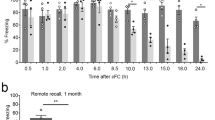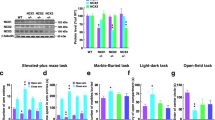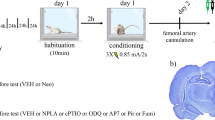Abstract
Rationale
Nitric oxide (NO) produced by neuronal nitric oxide synthase (nNOS) is a retrograde neuronal messenger that participates in synaptic plasticity, including late-phase long-term potentiation (LTP) and long-term memory (LTM) formation. Our recent studies have shown that nNOS knockout (KO) mice have a severe deficit in contextual fear conditioning compared to wild type (WT) counterparts (Kelley et al. 2009).
Objectives
Given the role of the nNOS gene in fear conditioning, we investigated whether systemic administration of modulators of NO signaling affect the formation of contextual and cued fear memories and the effects of these modulators on cyclic 3′5′-guanosine monophosphate (cGMP) levels in the hippocampus and amygdala.
Methods
The preferential nNOS inhibitor S-methyl-l-thiocitrulline (SMTC; 10–200 mg/kg) was administered (IP) to WT mice, and the NO donor molsidomine (10 mg/kg) was administered (IP) to nNOS KO mice either 30 min pretraining or immediately posttraining.
Results
Pretraining SMTC administration to WT mice impaired both short- and long-term memories of contextual (36% inhibition) but not cued fear conditioning. Pretraining molsidomine administration to nNOS KO mice improved their deficit in short- and long-term memories of contextual fear conditioning (46% increase). Posttraining drug administration had no effect on WT and nNOS KO mice. The systemic administration of SMTC dose-dependently decreased cGMP concentrations down to 25% of control, while molsidomine increased cGMP concentration (three- and five-fold) in amygdala and hippocampus, respectively.
Conclusions
These findings suggest that neuronal NO and its downstream second messenger cGMP are important for acquisition and subsequent consolidation of LTM of contextual fear conditioning.




Similar content being viewed by others
References
Abel T, Nguyen PV, Barad M, Deuel TA, Kandel ER, Bourtchouladze R (1997) Genetic demonstration of a role for PKA in the late phase of LTP and in hippocampus-based long-term memory. Cell 88:615–626
Arancio O, Antonova I, Gambaryan S, Lohmann SM, Wood JS, Lawrence DS, Hawkins RD (2001) Presynaptic role of cGMP-dependent protein kinase during long-lasting potentiation. J Neurosci 21:143–149
Balda MA, Anderson KL, Itzhak Y (2006) Adolescent and adult responsiveness to the incentive value of cocaine reward in mice: role of neuronal nitric oxide synthase (nNOS) gene. Neuropharmacology 51:341–349
Bilbo SD, Hotchkiss AK, Chiavegatto S, Nelson RJ (2003) Blunted stress responses in delayed type hypersensitivity in mice lacking the neuronal isoform of nitric oxide synthase. J Neuroimmunol 140:41–48
Blair HT, Schafe GE, Bauer EP, Rodrigues SM, LeDoux JE (2001) Synaptic plasticity in the lateral amygdala: a cellular hypothesis of fear conditioning. Learn Mem 8:229–242
Boess FG, Hendrix M, van der Staay FJ, Erb C, Schreiber R, van Staveren W, de Vente J, Prickaerts J, Blokland A, Koenig G (2004) Inhibition of phosphodiesterase 2 increases neuronal cGMP, synaptic plasticity and memory performance. Neuropharmacology 47:1081–1092
Brenman JE, Bredt DS (1997) Synaptic signaling by nitric oxide. Curr Opin Neurobiol 7:374–378
Campeau S, Miserendino MJ, Davis M (1992) Intra-amygdala infusion of the N-methyl-d-aspartate receptor antagonist AP5 blocks acquisition but not expression of fear-potentiated startle to an auditory conditioned stimulus. Behav Neurosci 106:569–574
Chien WL, Liang KC, Teng CM, Kuo SC, Lee FY, Fu WM (2003) Enhancement of long-term potentiation by a potent nitric oxide-guanylyl cyclase activator, 3-(5-hydroxymethyl-2-furyl)-1-benzyl-indazole. Mol Pharmacol 63:1322–1328
Chien WL, Liang KC, Teng CM, Kuo SC, Lee FY, Fu WM (2005) Enhancement of learning behaviour by a potent nitric oxide-guanylate cyclase activator YC-1. Eur J Neurosci 21:1679–1688
Denninger JW, Marletta MA (1999) Guanylate cyclase and the .NO/cGMP signaling pathway. Biochim Biophys Acta 1411:334–350
Esplugues JV (2002) NO as a signalling molecule in the nervous system. Br J Pharmacol 135:1079–1095
Furfine ES, Harmon MF, Paith JE, Knowles RG, Salter M, Kiff RJ, Duffy C, Hazelwood R, Oplinger JA, Garvey EP (1994) Potent and selective inhibition of human nitric oxide synthases. Selective inhibition of neuronal nitric oxide synthase by S-methyl-l-thiocitrulline and S-ethyl-l-thiocitrulline. J Biol Chem 269:26677–26683
Furini CR, Rossato JI, Bitencourt LL, Medina JH, Izquierdo I, Cammarota M (2009) beta-Adrenergic receptors link NO/sGC/PKG signaling to BDNF expression during the consolidation of object recognition long-term memory. Hippocampus
Hopper RA, Garthwaite J (2006) Tonic and phasic nitric oxide signals in hippocampal long-term potentiation. J Neurosci 26:11513–11521
Huang PL, Dawson TM, Bredt DS, Snyder SH, Fishman MC (1993) Targeted disruption of the neuronal nitric oxide synthase gene. Cell 75:1273–1286
Itzhak Y, Anderson KL (2007) Memory reconsolidation of cocaine-associated context requires nitric oxide signaling. Synapse 61:1002–1005
Joca SR, Guimaraes FS (2006) Inhibition of neuronal nitric oxide synthase in the rat hippocampus induces antidepressant-like effects. Psychopharmacology (Berl) 185:298–305
Kelley JB, Balda MA, Anderson KL, Itzhak Y (2009) Impairments in fear conditioning in mice lacking the nNOS gene. Learn Mem 16:371–378
Kessler RC, Chiu WT, Demler O, Merikangas KR, Walters EE (2005) Prevalence, severity, and comorbidity of 12-month DSM-IV disorders in the National Comorbidity Survey Replication. Arch Gen Psychiatry 62:617–627
Kim JJ, DeCola JP, Landeira-Fernandez J, Fanselow MS (1991) N-methyl-d-aspartate receptor antagonist APV blocks acquisition but not expression of fear conditioning. Behav Neurosci 105:126–133
Lu YF, Kandel ER, Hawkins RD (1999) Nitric oxide signaling contributes to late-phase LTP and CREB phosphorylation in the hippocampus. J Neurosci 19:10250–10261
Maren S (1998) Effects of 7-nitroindazole, a neuronal nitric oxide synthase (nNOS) inhibitor, on locomotor activity and contextual fear conditioning in rats. Brain Res 804:155–158
Maren S, De Oca B, Fanselow MS (1994) Sex differences in hippocampal long-term potentiation (LTP) and Pavlovian fear conditioning in rats: positive correlation between LTP and contextual learning. Brain Res 661:25–34
Meyer RC, Spangler EL, Patel N, London ED, Ingram DK (1998) Impaired learning in rats in a 14-unit T-maze by 7-nitroindazole, a neuronal nitric oxide synthase inhibitor, is attenuated by the nitric oxide donor, molsidomine. Eur J Pharmacol 341:17–22
Mineka S, Oehlberg K (2008) The relevance of recent developments in classical conditioning to understanding the etiology and maintenance of anxiety disorders. Acta Psychol (Amst) 127:567–580
Miserendino MJ, Sananes CB, Melia KR, Davis M (1990) Blocking of acquisition but not expression of conditioned fear-potentiated startle by NMDA antagonists in the amygdala. Nature 345:716–718
National Research Council (1996) Guide for the care and use of laboratory animals. National Academies Press, Washington
Ota KT, Pierre VJ, Ploski JE, Queen K, Schafe GE (2008) The NO-cGMP-PKG signaling pathway regulates synaptic plasticity and fear memory consolidation in the lateral amygdala via activation of ERK/MAP kinase. Learn Mem 15:792–805
Paul C, Schoberl F, Weinmeister P, Micale V, Wotjak CT, Hofmann F, Kleppisch T (2008) Signaling through cGMP-dependent protein kinase I in the amygdala is critical for auditory-cued fear memory and long-term potentiation. J Neurosci 28:14202–14212
Pham J, Cabrera SM, Sanchis-Segura C, Wood MA (2009) Automated scoring of fear-related behavior using EthoVision software. J Neurosci Methods 178:323–326
Phillips RG, LeDoux JE (1992) Differential contribution of amygdala and hippocampus to cued and contextual fear conditioning. Behav Neurosci 106:274–285
Prickaerts J, de Vente J, Honig W, Steinbusch HW, Blokland A (2002) cGMP, but not cAMP, in rat hippocampus is involved in early stages of object memory consolidation. Eur J Pharmacol 436:83–87
Puzzo D, Palmeri A, Arancio O (2006) Involvement of the nitric oxide pathway in synaptic dysfunction following amyloid elevation in Alzheimer’s disease. Rev Neurosci 17:497–523
Resstel LB, Correa FM, Guimaraes FS (2008) The expression of contextual fear conditioning involves activation of an NMDA receptor-nitric oxide pathway in the medial prefrontal cortex. Cereb Cortex 18:2027–2035
Rodrigues SM, Schafe GE, LeDoux JE (2001) Intra-amygdala blockade of the NR2B subunit of the NMDA receptor disrupts the acquisition but not the expression of fear conditioning. J Neurosci 21:6889–6896
Schafe GE, Bauer EP, Rosis S, Farb CR, Rodrigues SM, LeDoux JE (2005) Memory consolidation of Pavlovian fear conditioning requires nitric oxide signaling in the lateral amygdala. Eur J Neurosci 22:201–211
Sigurdsson T, Doyere V, Cain CK, LeDoux JE (2007) Long-term potentiation in the amygdala: a cellular mechanism of fear learning and memory. Neuropharmacology 52:215–227
Snyder SH, Bredt DS (1992) Biological roles of nitric oxide. Sci Am 266:68–71, 74–77
Tanda K, Nishi A, Matsuo N, Nakanishi K, Yamasaki N, Sugimoto T, Toyama K, Takao K, Miyakawa T (2009) Abnormal social behavior, hyperactivity, impaired remote spatial memory, and increased D1-mediated dopaminergic signaling in neuronal nitric oxide synthase knockout mice. Mol Brain 2:19
Taqatqeh F, Mergia E, Neitz A, Eysel UT, Koesling D, Mittmann T (2009) More than a retrograde messenger: nitric oxide needs two cGMP pathways to induce hippocampal long-term potentiation. J Neurosci 29:9344–9350
Wilson ID, Watson KV, Troke J, Illing HP, Fromson JM (1986) The metabolism of [14C]N-ethoxycarbonyl-3-morpholinosydnonimine (molsidomine) in laboratory animals. Xenobiotica 16:1117–1128
Zhuo M, Hu Y, Schultz C, Kandel ER, Hawkins RD (1994) Role of guanylyl cyclase and cGMP-dependent protein kinase in long-term potentiation. Nature 368:635–639
Acknowledgements
This work was supported by RO1 DA026878 from the National Institute on Drug Abuse, National Institutes of Health, USA (YI).
Author information
Authors and Affiliations
Corresponding author
Rights and permissions
About this article
Cite this article
Kelley, J.B., Anderson, K.L. & Itzhak, Y. Pharmacological modulators of nitric oxide signaling and contextual fear conditioning in mice. Psychopharmacology 210, 65–74 (2010). https://doi.org/10.1007/s00213-010-1817-8
Received:
Accepted:
Published:
Issue Date:
DOI: https://doi.org/10.1007/s00213-010-1817-8




